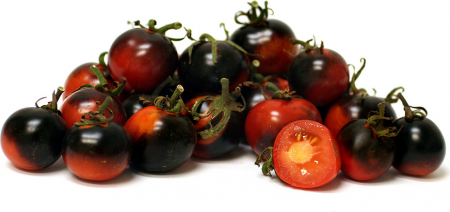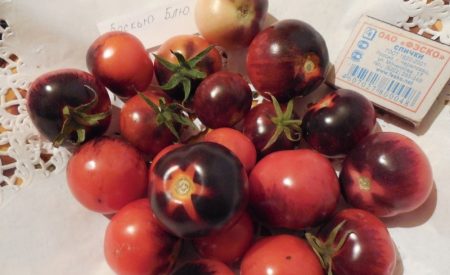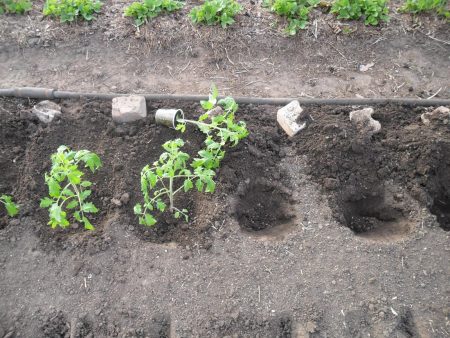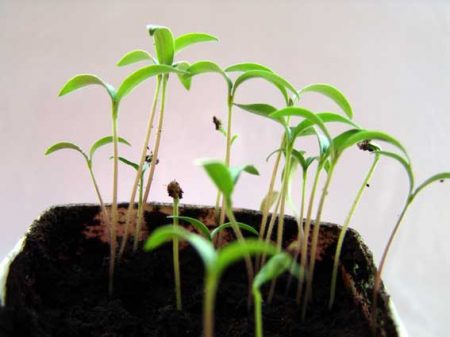 Tomato Basque blue (Bosque blue) - mid-season, semi-determinant variety, bred in the USA in 2012. We still rarely see it, in some catalogs it can be found under such names as Bosquay Blue, Blue Forest and Bosque Blue.
Tomato Basque blue (Bosque blue) - mid-season, semi-determinant variety, bred in the USA in 2012. We still rarely see it, in some catalogs it can be found under such names as Bosquay Blue, Blue Forest and Bosque Blue.
Tomatoes have an unusual color, which changes as they ripen from dark green and deep blue to red yellow or orange. The fruits are rich in anthocyanin, it has bactericidal properties and has a positive effect on vision. Let's get acquainted with the main characteristics and rules of growing basque blue tomato.
Content
Description of Basque Blue tomato
In regions with a temperate and warm climate, the variety can be grown in unprotected soil. In cooler cities with unstable weather conditions, it is planted in greenhouses. The first crop is harvested 120–125 days after seed hatching.
Bush and fruit characteristics
In open ground conditions, the crown height by the end of the growing season does not exceed one and a half meters. In the greenhouse, the plant can stretch up to 250 cm. The leaves are regular, ordinary, at the first stages they are green with a blue tint, which disappears over time. The bush develops very quickly, it is massive and strong, branched.
The first brush appears above 6 or 7 leaves, subsequent inflorescences are formed every 2-3 leaves. The brushes are very beautiful, elongated, contain up to 8 fruits, and sometimes even up to 10. Flowering and knotting together the tomato continues until the first autumn frosts.
The variety is highly resistant to the most common diseases of the culture, is not attractive to pests. Basque Blue tomato is picky about light, tolerates a short-term temperature drop to +7 degrees, but immunity to drought is very weak.
The fruits are fleshy, rounded, uniform, weighing from 30 to 100 grams. In the context of tomatoes, pink-red. Seed chambers no more than 2, a lot of seeds. When fully ripened, the tomatoes below are reddish-orange, and the shoulders are blue-violet.
The flesh is pink-red juicy and tender, the taste is tomato, very pleasant - sweet with a barely noticeable acid and fruity aroma. The skin is smooth, dense, but there is a risk of cracking if the fruit is not watered or oversized.
Use and yield
Fresh Basque Blue tomatoes are not only amazingly delicious, but also very healthy. The content of anthocyanins is not lower than that of blueberries. Also, the variety is suitable for various kinds of processing. For drying this tomato is not used.
The overall yield indicator is quite high, but it can be indicated only in approximate figures. On average, at least 5-7 kilograms of tomatoes are removed from one bush for the entire season.
The main advantages and disadvantages of the variety
Tomato Basque Bleu has a lot of advantages. Although there are few reviews about this rare variety, they are mostly positive:
- high yields in almost all regions of Russia;
- excellent appearance of the fruit, good taste and versatility in use;
- extended fruiting period, the crop is harvested until late autumn. Unripe tomatoes can be left for ripening;
- resistance to low temperatures, viruses, fungi and pests;
- seeds can be collected independently, they are well stored;
- unpretentiousness, simplicity in cultivation.
Varieties also have disadvantages:
- tendency to crack fruit;
- poor resistance to heat and drought.
It is worth noting that if you select the right growing conditions in a particular region and follow the advice of agricultural technology, there will be no problems.
How to grow a basque blue tomato
You need to sow seeds 65 or 70 days before the intended planting of the plants in a permanent place (usually from late February to mid-March). The exact date is determined based on the weather factors of a particular region and growing conditions. Seeds, soil and containers are prepared in advance. Grains need to be sorted, pickled and soaked in a nutrient mixture. The soil taken from the garden or garden should be decontaminated in any convenient way.
Seedlings are grown according to the same rules as for any other varieties. Gardeners often shorten the root of tomato seedlings when diving, it is undesirable to carry out such a procedure with Basque blyu tomato. Hardening seedlings for this variety is required.
Landing and care
No more than 4 seedlings are placed on one square meter, they are formed in 3 or 4 trunks. Trellises or pegs are installed in advance, the bush needs to be tied up as it grows. The place where the basque blue tomato will grow should be open and preferably calm, even a slight shadow will have a negative effect.
When removing stepchildren, small stumps should be left. The sheets in the lower part of the bush are cut, the crown can not be thinned. There is no special need for hilling, but all weed grasses need to be cleaned on time until they have attracted pests. The soil is loosened from time to time. Watering is carried out 1 or 2 times a week. In particularly hot periods, the ground should be covered with a good layer of mulch and give the bushes more moisture.
Basque Bleu is fed regularly (every 15–20 days), organic and mineral complexes are suitable. With nitrogen fertilizers, you should be careful, they are best used only when absolutely necessary.
Basque blue - an excellent variety, planting and growing will not bring absolutely any trouble. The care is standard, a beginner in gardening can easily cope with this tomato. Disease immunity persists even when planted under conditions unfavorable for the tomato.
Reviews
Natalya. I got seeds in a package with a different grade. During growing seedlings, noticed that 2 bushes have a strange blue tint. I didn’t throw it away, it was interesting that it would grow. For 3 years I have never regretted my decision. Tomatoes are fruitful, very tasty and beautiful. The bushes are strong, grow very quickly, unripe tomatoes are almost black in color. The variety is not prone to disease and tolerates a sharp change in day and night temperatures.
Vitaliy. I don’t really like blue tomatoes, I prefer pink and red. I bought Basque blue for the sake of interest and I, oddly enough, liked it. The taste is very saturated tomato, pleasant. I live in the Moscow region, plant a variety in a greenhouse, every season we remove it last, while the bush is still covered with fruits. This year I want to plant several tomatoes on the street, they say that in such conditions, tomatoes are tied earlier.




 Low-growing tomatoes, without pinching: 5 of the most delicious varieties
Low-growing tomatoes, without pinching: 5 of the most delicious varieties Why tomato seedlings grow poorly
Why tomato seedlings grow poorly We grow a tomato in a shell
We grow a tomato in a shell Growing tomatoes without watering according to the method of Kazarin
Growing tomatoes without watering according to the method of Kazarin